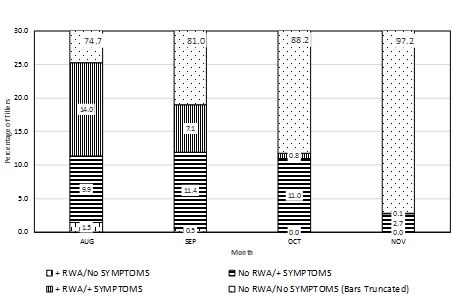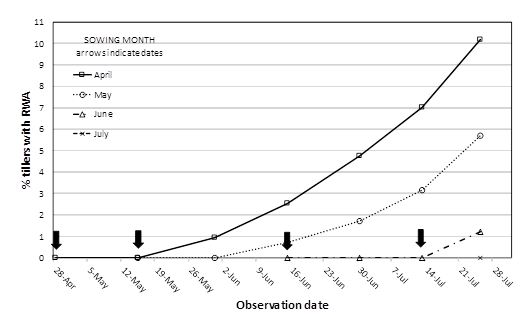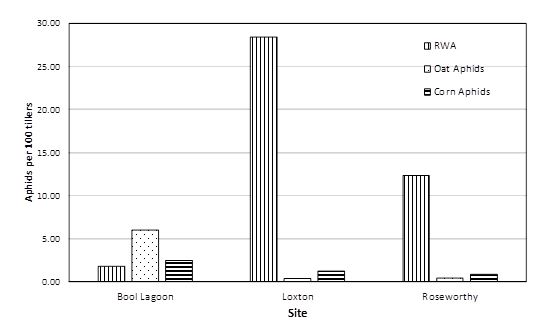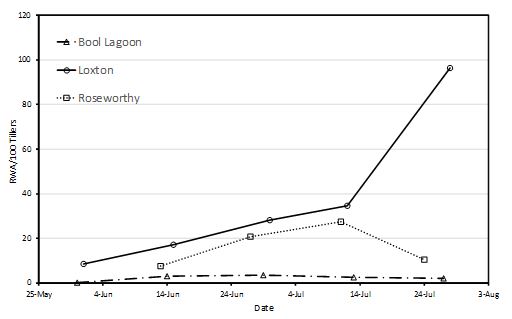Russian wheat aphid dynamics in 2017
Author: Maarten van Helden and Greg Baker (South Australian Research and Development Institute, Waite Campus, Adelaide) | Date: 22 Aug 2017
Take home messages
- Russian wheat aphid (RWA) is now present all over SA.
- Populations this year seem generally less abundant than in 2016.
- Cold and wet weather seems to reduce populations in the high rainfall areas of the state.
- In early sown paddocks in the low rainfall areas of the state aphid infestations can be higher and populations seem to increase steadily.
- Seed treatments have prevented early autumn infestation of crops, but aphids could invade and build up later in the season.
Occurrence and current distribution in South Australia
Russian wheat aphid (Diuraphis noxia, RWA) is one of the most economically important pests of wheat, barley and other cereal grains in dryland cereal production areas worldwide. After the initial detection in Tarlee in 2016, further surveillance has led to the detection all over SA, including the Eyre Peninsula.
This season, researchers are closely following the infestations and population dynamics in different climatic zones of SA (Mid North: Roseworthy; Mallee: Loxton; South East (Bool Lagoon) and testing different sowing dates and seed treatments to determine best practice management strategies.
Expected population dynamics
From overseas data and last years’ observations the following population dynamics can be expected during a cropping season:
- In autumn, aphids may infest wheat or barley seedlings soon after emergence, either from wingless aphids walking off nearby senescing hosts, or migrating winged aphids. Early in the crop cycle, the vast majority of aphids are wingless. In cereal regions of the world where RWA causes problems, populations start to increase from tillering and stem elongation. Aphids can move by walking among leaves, tillers and plants, so that the percentage of infested plants increases during the crop cycle. Population growth often becomes most rapid from booting onwards. Aphids feed in dense colonies, typically at the base and sheath of younger leaves and within leaves curled by their feeding. Aphids prefer the newest leaves of plants, and are often found on the last two leaves unfurled.
- Later in the crop cycle as aphid population density increases, the proportion of winged aphids increases and may reach high levels prior to ripening — at this stage, aphids emigrate in search of alternative summer hosts. Winged RWA are weak flyers, but are thought to travel on wind currents efficiently enough for some aphids to locate isolated host plants.
RWA are able to survive under a wide range of temperatures (including frost), the optimum temperature range for development is considered to be around 18 to 21°C. Generation time ranges from approximately 20 days at 10°C and 9 days at 20°C. Damaging RWA populations generally occur in dry weather conditions.
Like other aphids, populations of RWA are strongly regulated by environmental conditions. Survival of aphids is affected by exposure to rainfall, drying winds, predators, parasitoids and entomopathogens. Rainfall washes aphids from upper leaves and heavy rainfall may cause mortality of up to half of the population.
Detection, identification and population estimates
Aphids may infest crops during any stage of crop development, from early establishment to maturing flag leaf. Consequently it is important the growers check crops regularly following seedling emergence. Infestations often begin along crop edges, usually on the windward side or adjacent to infested grasses or volunteer cereals. Aphid infestation is often higher in areas of the paddocks where plants are sparse, on sandy rises or adjacent to bare ground where plants are stressed due to water stress or diseases.
Russian wheat aphids are often difficult to find when at low numbers so check first for the very characteristic and distinctive leaf streaking and rolling occurring on the plants shortly after colonisation. New leaves also do not unroll completely, causing more rigid folded leaves to be visible.
Russian wheat aphids are usually only detected on plants with symptoms, often hiding inside the still rolled leaves. Aphids are lime-green and lack the siphunculi (exhaust pipes), which distinguish them from oat and corn aphids. The (rarely observed) rose-grain aphid looks similar to the RWA but has long siphunculi and a darker green dorsal stripe.
Unlike other cereal aphids that damage plants by removing nutrients, RWA inflicts plant damage by injecting salivary toxins during feeding that cause rapid, systemic phytotoxic effects on plants, resulting in acute plant symptoms and potentially significant yield losses. Even a few aphids can cause symptoms to appear as early as seven days after infestation. These plant damage symptoms include:
- White and purple longitudinal streaks on leaves.
- Curled, rolled or hollow tube leaves.
- Stunted growth or flattened appearance.
- Discolored leaves.
- Hooked-shaped head growth from awns trapped in curling flag leaf.
- Bleached heads.
RWA is not known to be a major vector of cereal viruses such as Barley Yellow Dwarf Virus (BYDV) (Damsteegt et al., 1992).
The extent of aphid infestation can be estimated by:
- Counting the percentage of plants or tillers with symptoms (for example, at four locations in the paddock count all tillers on a 50cm row length and also count the tillers with symptoms).
- Then check and count for the presence of aphids on at least 20 symptomatic tillers (i.e. tillers showing symptoms).
- Do these observations at least every two weeks.
This allows a quick and easy but reliable estimation of the infestation frequency (tillers) and intensity (aphids/tiller). It is important to know how these values evolve over time to better appreciate the risk of damage occurring during flowering and ripening.
Checking for the actual presence of the aphids in the tillers with symptoms is important because:
- The presence of large colonies with big (adult) aphids, many small nymphs and many small white cast skins, is a clear indication of aphid population build up.
- It is not unusual that tillers showing symptoms do not contain aphids any more, especially if the aphid population is on the decline. This was very obvious during the spring population decline in 2016 (Figure 1).
Figure 1. Percentage of tillers with/without symptoms and aphids during 2016. Note: many tillers with symptoms contained no aphids, especially later in the season.
- Checking allows for observation of natural enemies (for example, lacewing larvae, hoverfly maggots, ladybeetles), mummified (brown) aphids which have been attacked by parasitic wasp, and aphids infested by fungi (that look dull and ‘fluffy’).
- Be aware that in the rolled leaves of tillers with symptoms, other aphid species (oat aphid, corn aphid, etc.) are often present, but these are less likely to cause damage.
If the aphid population increases to levels over the intervention threshold, then it is recommended that plants be sprayed with either chlorpyrifos or pirimicarb insecticides.
Currently only provisional intervention thresholds are available which are based on American literature (Pike and Alisson, 1991). These are:
- Up to the start of stem elongation (GS 32): >20% of all plants infested with aphids.
- From late stem elongation to flowering stage: >10% of all tillers infested with aphids.
If aphids are controlled, new growth proceeds normally (new roots and shoots are unaffected) and plants recover unless excessively stressed. After soft dough stage, further impact of the aphids is thought to be minimal, and therefore, after this stage insecticide application is not advised and pre-harvest intervals must be respected (allow six weeks for pirimicarb!).
Observed population dynamics in 2016
Last year the initial RWA outbreak was mainly observed in early sown crops where aphids moved from the dying volunteer cereals to the newly emerging seedlings. In spite of sometimes high infestations (up to 50% of plants) occurring in late August, these were controlled naturally in September due to entomopathogenic fungi and very high rainfall in Victoria and SA. When the aphids disappeared the plants recovered well, growing through the symptoms (Figure 2), and no yield losses were recorded in our spring trials last year.
Figure 2. 2017 RWA population over time in relation to sowing date
2017 population dynamics in South Australia…
In the 2017 summer season RWA populations were observed on volunteer cereals in all cropping areas. Most growers have managed to control this green bridge in late summer and few significant attacks have been reported so far. Observations showed that aphid populations are present throughout SA, but infestations were initially low in early sown paddocks (0.1 to 0.5% of plants) and almost non-existent in later sown paddocks (Figure 3).
Many growers also chose to use seed treatments that controlled early infestations. Interestingly, paddocks where seed treatments were used can still show some symptoms due to migrating aphids attempting to feed, but aphids were then eliminated by the systemic insecticides.
Figure 3. 2017 percentage of tillers with RWA symptoms at four different times of sowing.
In a SAGIT funded trial different sowing dates are being tested. The data indicates that over time the RWA populations have been building up and the percentage of tillers infested have steadily increased until now (end of July 2017). Early (April) sown plots show up to 50 aphids/100 tillers and 10% of plants show symptoms (Figure 2 and 3) especially in the Mallee area. Later sown plots have a much lower aphid population.
RWA is the dominant aphid species present in the Mallee (Loxton) and the Mid-North (Roseworthy) trials compared with other aphid species (Figure 4). Number of aphids and symptom expression differs depending on cereal variety (data not shown) and aphids are still absent from seed-treated plots (now up to 12 weeks after sowing). Aphid populations have recently stabilised or declined in high rainfall areas but have kept increasing rapidly in the low rainfall Mallee region (Figure 5).
Figure 4. Type and number of aphids present at the Bool Lagoon, Loxton and Roseworthy trial site, July 2017.
Figure 5. RWA dynamics per site on April and May 2017 sowing. Note increase in Mallee numbers while others decline.
Control measures will not be applied in these experiments and researchers will continue to observe population dynamics and measure yield, to determine:
- Whether these observations can be used for a better, more precise damage estimate?
- If seed treatments are an effective treatment for the control of aphids throughout the season?
- What are the intervention thresholds for local cropping situations?
In parallel with these trials, trials in Adelaide and Loxton with artificial aphid infestation are being conducted with GRDC investment. Cereals (barley, wheat and durum wheat) are being grown in outdoor ‘tent cages’ and infested either in autumn or spring. In half of the autumn infested cages the aphids will be controlled during winter, and the remainder will receive no treatment. Aphid populations, plant development and yield will be recorded and compared to untreated controls to determine:
- How much damage can occur?
- If yield is affected by infestation that occurs during autumn but is controlled during winter?
- If spring infestation alone can cause harm?
Acknowledgements
The research undertaken as part of this project is made possible by the significant contributions of growers through both trial cooperation and the support of the GRDC — the author would like to thank them for their continued support. The work presented here was funded through GRDC projects (DAS00170, Service Agreement 9174815) and SAGIT project CARASA.
The authors would also like to Thomas Heddle, Farah Al-Jawahiri, Clare Svilans for the SA observations and all growers for their support.
Useful resources
Crop Aphids: The back pocket guide. GRDC
GRDC Paddock Practices - Monitor RWA numbers closely over winter
PIRSA (2016). Cereal Aphid dynamics
PIRSA Russian wheat aphid information
PestFacts newsletter Russian wheat aphid
Plant Health Australia – Threat Specific Contingency Plan
References
Avila, G., Davidson, M., van Helden, M., L. Fagan (2017). The potential risk of the Russian wheat aphid (Diuraphis noxia) establishing in New Zealand (submitted to Agric. And Forest Entomology).
Damsteegt, V.D., F.E. Gildow, A.D. Hewings, T.W. Carroll (1992) A clone of the Russian wheat aphid (Diuraphis noxia) as a vector of barley yellow dwarf barley stripe mosaic, and brome mosaic viruses. Plant Dis., 76 (1992), pp. 1155–1160
Heddle, T., van Helden, M., M. Nash (2016). Parasitoids of the Russian Wheat Aphid in Australia. Poster presented at the Australian Entomological Society 47th AGM and Scientific Conference and Entomological Society of New Zealand – 2016 Conference, Melbourne Nov 27-30 2016.
Hughes, RD. (1996) A synopsis of information on the Russian wheat aphid, Diuraphis noxia (Mordwilko).(Revised edition). CSIRO Australia Division of Entomology Technical Paper. 1996(34).
Pike KS, D. Allison(1991) Russian wheat aphid. Biology, damage and management. Pacific Northwest Cooperative Extension Publication. 1991 (PNW371).
Wilde GE, Whitworth, R,J., Claassen, M., R.A.Shufran (2001) Seed treatment for control of wheat insects and its effect on yield. Journal of Agricultural and Urban Entomology 18: 1-11. 2001
Yazdani, M., Baker, G., DeGraaf, H., Henry,K., Hill, K., Kimber, B., Malipatil, M., Perry, M., Valenzuela, I., MA Nash (2017). First detection of Russian wheat aphid Diuraphis noxia Kurdjumov, 1913 (Hemiptera:Aphididae) from Australia: a major threat to cereal production. Austral Entomology (in Press).
Contact details
Maarten van Helden
SARDI, Waite Building, Waite Rd, Urrbrae, SA
08 8303 9537
Maarten.vanhelden@sa.gov.au
@PestFactsSARDI
GRDC Project Code: DAS00170, SA 9174815,
Was this page helpful?
YOUR FEEDBACK





